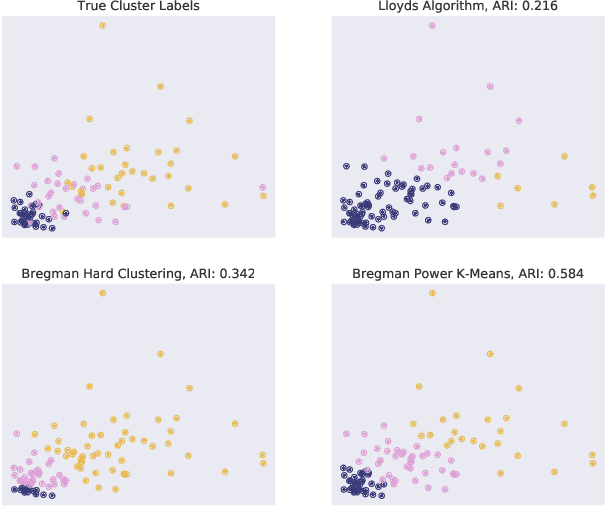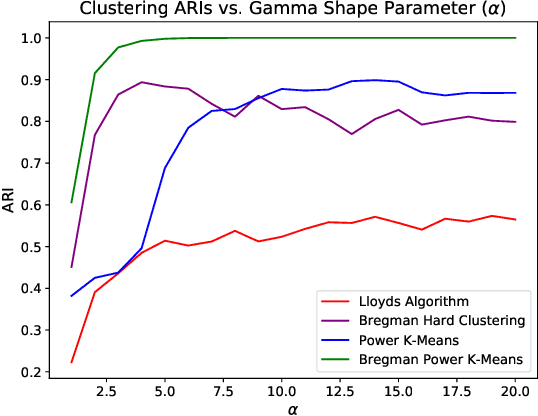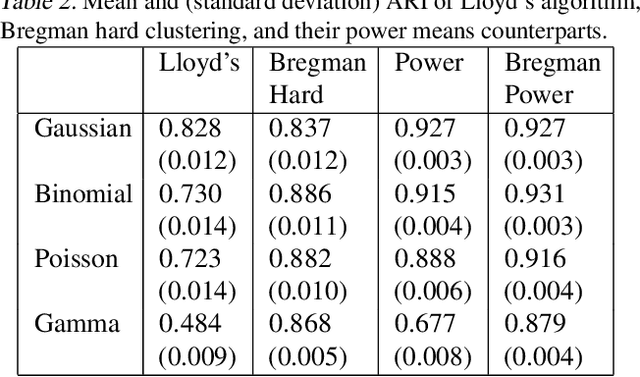Adithya Vellal
Bregman Power k-Means for Clustering Exponential Family Data
Jun 22, 2022



Abstract:Recent progress in center-based clustering algorithms combats poor local minima by implicit annealing, using a family of generalized means. These methods are variations of Lloyd's celebrated $k$-means algorithm, and are most appropriate for spherical clusters such as those arising from Gaussian data. In this paper, we bridge these algorithmic advances to classical work on hard clustering under Bregman divergences, which enjoy a bijection to exponential family distributions and are thus well-suited for clustering objects arising from a breadth of data generating mechanisms. The elegant properties of Bregman divergences allow us to maintain closed form updates in a simple and transparent algorithm, and moreover lead to new theoretical arguments for establishing finite sample bounds that relax the bounded support assumption made in the existing state of the art. Additionally, we consider thorough empirical analyses on simulated experiments and a case study on rainfall data, finding that the proposed method outperforms existing peer methods in a variety of non-Gaussian data settings.
Normalization of breast MRIs using Cycle-Consistent Generative Adversarial Networks
Dec 16, 2019



Abstract:Dynamic Contrast Enhanced-Magnetic Resonance Imaging (DCE-MRI) is widely used to complement ultrasound examinations and x-ray mammography during the early detection and diagnosis of breast cancer. However, images generated by various MRI scanners (e.g. GE Healthcare vs Siemens) differ both in intensity and noise distribution, preventing algorithms trained on MRIs from one scanner to generalize to data from other scanners successfully. We propose a method for image normalization to solve this problem. MRI normalization is challenging because it requires both normalizing intensity values and mapping between the noise distributions of different scanners. We utilize a cycle-consistent generative adversarial network to learn a bidirectional mapping between MRIs produced by GE Healthcare and Siemens scanners. This allows us learning the mapping between two different scanner types without matched data, which is not commonly available. To ensure the preservation of breast shape and structures within the breast, we propose two technical innovations. First, we incorporate a mutual information loss with the CycleGAN architecture to ensure that the structure of the breast is maintained. Second, we propose a modified discriminator architecture which utilizes a smaller field-of-view to ensure the preservation of finer details in the breast tissue. Quantitative and qualitative evaluations show that the second proposed method was able to consistently preserve a high level of detail in the breast structure while also performing the proper intensity normalization and noise mapping. Our results demonstrate that the proposed model can successfully learn a bidirectional mapping between MRIs produced by different vendors, potentially enabling improved accuracy of downstream computational algorithms for diagnosis and detection of breast cancer.
 Add to Chrome
Add to Chrome Add to Firefox
Add to Firefox Add to Edge
Add to Edge